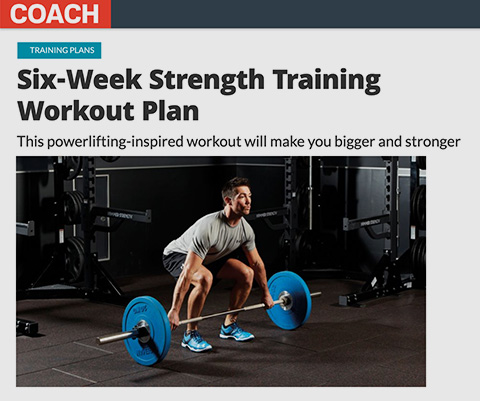Preseason conditioning strategies for joint and muscle injury prevention
Implementation at Leighton Town FC
Season 2019/20
These treatment strategies can also be used for rehabilitation and recovery following a sports injury
Muscle and joint injuries impact on an individual player in any sport. Injuries reduce player availability and functional movement. In a team sport, loss of players impacts on the team performance and success achieved. Deficits in strength, flexibility, balance and agility also impair function, restricting performance even without injury.
The strategy for Leighton Town FC this preseason is to prepare players to reduce injury levels in training. Correct conditioning should reduce the level of player injury throughout the season. Of course, it is impossible to protect against impact injuries.
Evidence from the UEFA football injuries study and FIFA Medical Network indicate that injury levels in training preseason and throughout a season are reduced proportionally to the number of preseason training sessions. 25-40 preseason sessions corelate to less injury through a whole season. Injury figures are higher with <25 preseason sessions. These figures are supported from research in other sports: ie Rugby League and Ice Hockey.
Injuries affect team performance negatively in professional football: an 11-year follow-up of the UEFA Champions League injury study bjsm.bmj.com
A person moving with symmetry is less prone to injury. Factors which affect normal movement patterns are:
- Strength
- Flexibility
- Coordination, Balance and Proprioception
- Stamina
- Mental focus
- Preparation and Recovery
Strength and flexibility are relatively easy to train and achieve. Stamina comes from correct conditioning drills. Mental focus can be improved by listening to the player, addressing their needs and concerns and athlete specific training programs. Diet and hydration are critical in preparation and recovery. Often neglected factors, particularly for postgame recovery, are sleep, rest, gentle movement drills and massage.
Skeletal Alignment
It is my opinion, refined through many years in practice and working in many different sports, that body balance lies at the heart of optimal movement. This requires the core elements of the body, the spine, pelvis, neck and head to be correctly aligned. Restricted head or neck movement will have a negative effect on movement coordination and balance. This is because when you run or turn your spine makes fine adjustments to keep you head level. Stiff neck segments prevent this fine correction. Restricted spinal movements prevent normal muscle functional and the fine muscle adjustments required to achieve symmetry.
The bones of the pelvis, the sacrum and alia, are torque converters, transmitting forces from the lower limbs to the spine, abdomen and upper body. If the pelvic structures are misaligned, forces are incorrectly transferred and body function impaired. Segment restriction in the pelvis or neck can limit correct flexibility and impair muscle strengthening.
My training regimes dictate that you must correct the core elements before you try to build strength and stamina. Poor central body core balance inhibits training achievement. Therefore, we should insert at the top of the list:
- Correct body alignment is essential prior to training the elements below
- Strength
- Flexibility
- Coordination, Balance and Proprioception
- Stamina
- Mental focus
- Preparation and Recovery
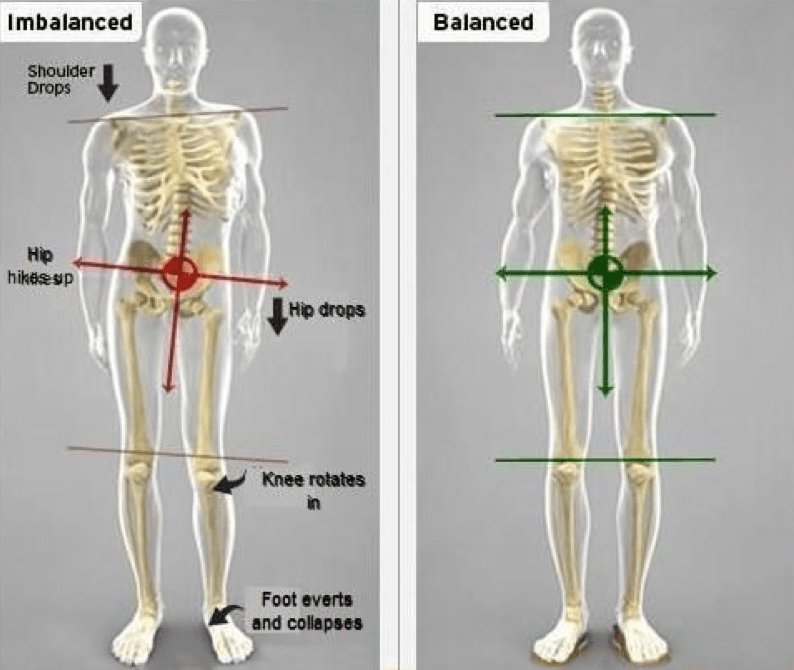
This image demonstrates the various joints involved in body balance deficits. Corrections have to be made to facilitate optimal benefits from strength and conditioning strategies.
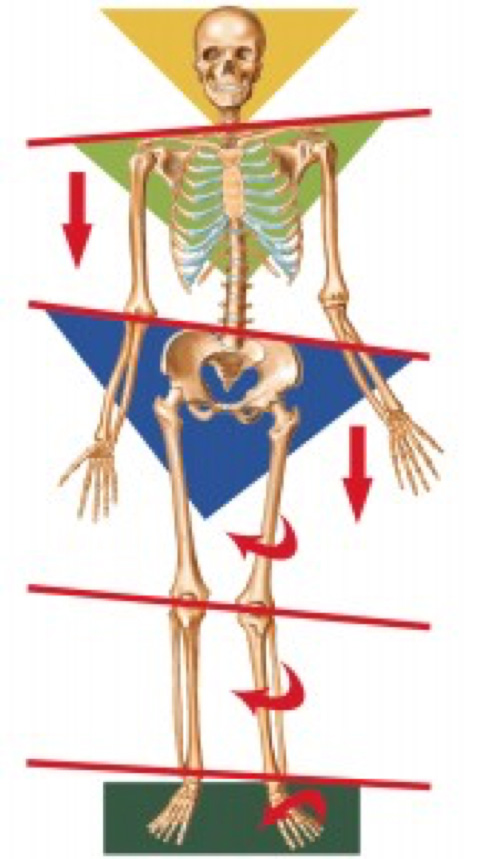
Altered joint movemd position affect alignment of the head and neck during running, cutting and jumping. If the head is not stable during body movement, balance, coordination and, consequentially, function will be deficient.
Hip and spine forward movement (Flexion) requires a balance ratio of 80/50deg, a ratio of approximately 1.6. If this ratio is less, say with restricted hip range of motion of less than 80 deg. and the spine has to contribute more, normal movement can be compromised and pain caused in the back or hips.
Taking the example of an ankle injury, the alignment of the bones comprising the foot and ankle are displaced from their normal anatomical position. The position of these bones must be correct before all the traditional ankle rehab protocols. This aspect of recovery is often neglected. It should be the basis of all rehab. Without correct position of individual bones, the complete joint function is hard to achieve.
Alignment deficits in the ankle can have a negative affect on other joints, stressing the knee and back for example. Conversely, poor alignment of the spine can transfer negative stress to the hip or ankle.
Muscle Training
Muscle strength is essential for an athlete to compete at the top level. Once you achieve body alignment, strength can be built more effectively. Muscle strength must be balanced in opposing muscle groups which work together to control a joint. The Quadriceps/Hamstring strength ratio should be 100%/60-70%. Hip Abductor/Adductor ratio, research suggests, should be 100%/80%.
Individual muscle training will protect a single joint. However, function occurs using muscle combinations. This means muscles work in groups to achieve correct function. They must be trained in groups. Muscles need to provide dynamic function with stability.
Muscles of the legs provide acceleration and deceleration at different times. The forces in these leg muscles combine with those of muscles of the trunk to provide stability of the pelvis and back.
Stability, acceleration and deceleration must be synchronised if injuries are to be prevented. Upright posture and running require muscles in the posterior back line: Gluteus Maximus and Latissimus Dorsi, plus connective tissue (Fascia) which provides tension and storage of kinetic energy for release later in the movement cycle. Other dynamic muscle groups include the hip adductor muscles working with internal and external abdominals and utilising the thoracolumbar fascia for greater tension. Spinal muscles are linked to leg muscle through dynamic functional chains of movement.
Consequences of poor muscle balance are deficits in core stability. A weak buttock muscle can increase stress on a hamstring muscle, leading to a greater risk of injury. Hip muscle weakness can negatively effect knee control, increasing stress on the knee joint. Research indicates a higher risk of knee and calf injury. There can be acceleration and deceleration deficits, another injury risk. As one muscle group contracts another is providing control and stability. These muscle groups working together and reciprocally provide correct placement when the standing leg hits the ground. The demands are higher when running and turning.
Research indicates specific training of the VMO, inner Quadriceps muscle, is ineffective in isolation. Rehabilitation time would be better utilised on core stability, hip Add/Abd, Int/Ext rotation strategies and controlling joint mechanics.
This exercise involves gluteal and hamstring muscles working with the core trunk muscles.
Lines of force control, energy and tissue stress balance when muscle work as groups

Courtesy of Thomas Myers: Anatomy Trains
Weakness of a specific muscle in a dynamic chain, can cause weakness or tension in other areas of the same chain. Tensions in areas of the muscle chain can cause weaknesses elsewhere. Evaluation and treatment of a whole dynamic body line may be required to resolve weakness and areas of tightened muscle and fascia.
Ultrasound Imaging to clarify diagnosis of pathology
I use Ultrasound imaging in the practice to clarify pathology of injuries including muscle, tendons and ligaments. The images will identify structural tears, fluid and calcified tissue. The degree of tissue damage can be identified, and healing progress monitored. Imaging will assist in planning an effective rehabilitation program.
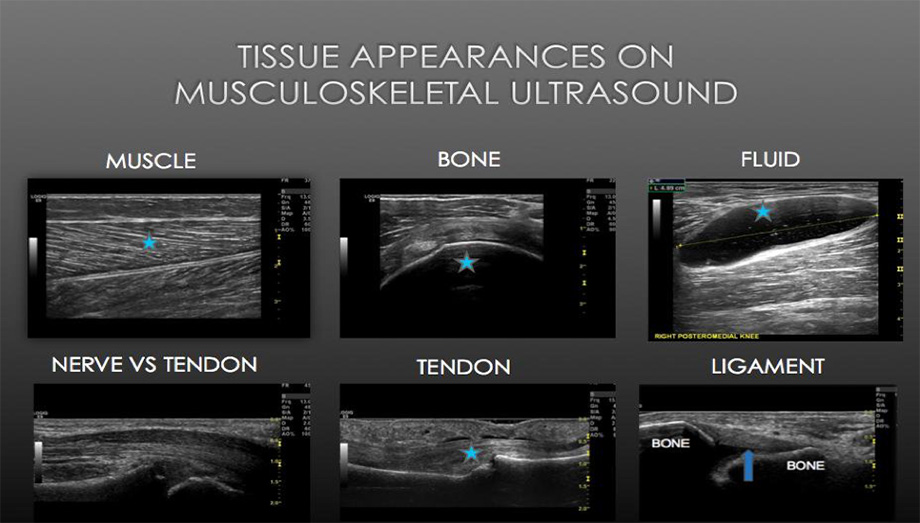
This image shows how various tissue will appear on Ultrasound Imaging
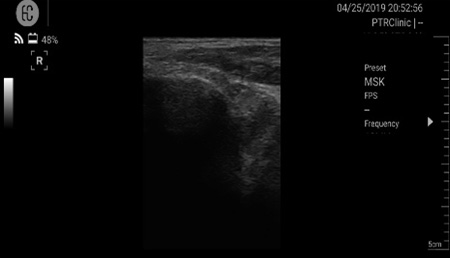
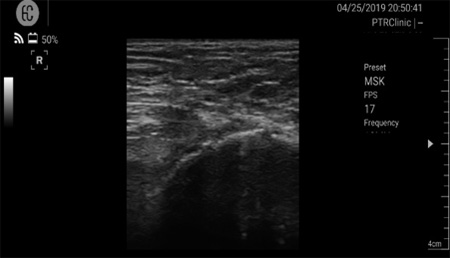
Image a,b: Achilles tendon fibres -Gastrocnemius and Soleus muscles
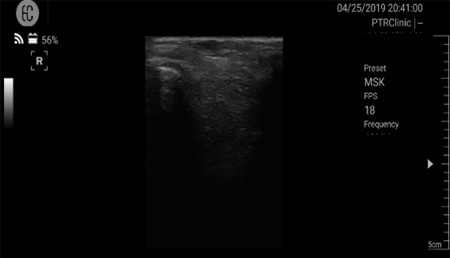 Image c: Searching for damage to the lateral ankle ligament
Image c: Searching for damage to the lateral ankle ligament
Injury prevention and rehabilitation Strategies
I use a variety of dynamic exercise drills for conditioning and injury prevention. These strategies are also useful for injury rehab. They are targeted at the hip muscles to prevent groin injury, the hamstring muscles, Quads (front of thigh) and calf muscles. Core stability of the abdominal and back muscles can be trained using a swiss ball, planks, squats and lunges with weights. I prefer to train core stability in standing as this is more functional. Crunches and sit ups may work but are less functional and can irritate the spine. Russian Twists are an individual preference.
Conditioning should start with slow sprinting drills: knee kicks, butt kicks, bounding and cutting, then progressed to single leg hopping. All planes of movement are beneficial, frontal, side and diagonals.
Mach drills are very effective for warm up, conditioning and rehab.
Hurdle drills are effective for leg and spine mobility, conditioning and muscle flexibility. They are useful for various sports, however, you need to consider if there are functional benefits during football training.
Hamstring Muscle
The Hamstring muscles have to control the hip and knee joints. This mechanical demand can make them vulnerable to damage. During acceleration from standing the long head of the biceps femoris (outside muscle at back of thigh) is most prone to injury. If stretching the leg in a football sliding tackle or a full speed follow through kick, the semimembranosus (inside of back of thigh) is more commonly injured. Training strategies using the hip and knee together are recommended. Research suggests specific exercise will target different muscles of the hamstring complex.
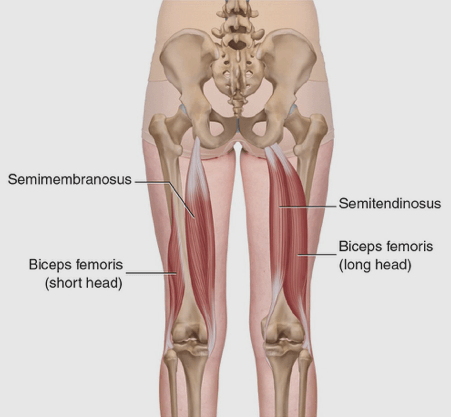
Muscle specific Hamstring Exercise
Hip Adduction
Preventing Adductor muscle injuries requires good flexibility of the hip and pelvis, strong core stability and strong Adductor muscles. Adductor muscle strength is essential to prevent injury. There are numerous research articles supporting the importance of strength and training regimes. Dynamic running, hopping and cutting drills are effective conditioning for injury prevention.
Areas of potential hip pain where stress affects different structures
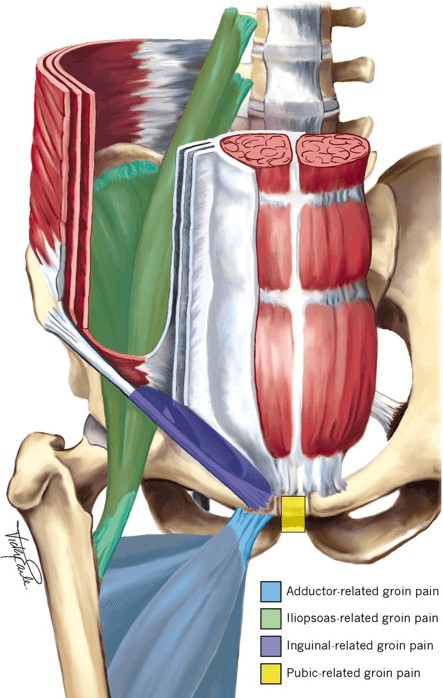
Courtesy of the British Journal of Sports Medicine
Figure 1 Defined clinical entities for groin pain. Adductor-related groin pain: Adductor tenderness AND pain on resisted adduction testing. Iliopsoas-related groin pain: Iliopsoas tenderness+more likely if pain on resisted hip flexion AND/OR pain on hip flexor stretching. Inguinal-related groin pain: Pain in inguinal canal region AND tenderness of the inguinal canal. No palpable inguinal hernia is present. More likely if aggravated with abdominal resistance OR Valsalva/cough/sneeze. Pubic-related groin pain: Local tenderness of the pubic symphysis and the immediately adjacent bone. No particular resistance tests to test specifically for pubic-related groin pain.
Doha agreement meeting on terminology and definitions in groin pain in athletes bjsm.bmj.com
Plyometrics
Plyometric drills are excellent in building stability as a precursor to running, jumping and turning. They can be performed as jumps in standing, sideways, forwards or diagonals. Bouncing on and off boxes of various heights can be used as a progression. This can be done as forward, backward and side jumps. They toughen the joint and muscle fibres and improve the concentric and eccentric muscle fibre co-contractions. Stability recruitment for joint and muscle structures is enhanced when the body lands from height, on one or two legs, and has to adjust to ground reaction force.
Focal Gluteal muscle and core strengthening
Muscle strength is essential for optimal performance and injury prevention. Meta-analysis research supports this strategy. The program cited below is, in my opinion, highly effective if well supervised.
Discussion
Professional football clubs, as in other sports have all the facilities and, I assume, all the expertise. Sports medicine in nonprofessional sport uses the same research and treatment strategies. As we progress from preseason to match play, we should be able to evaluate the progress and effectiveness of our prevention and treatment programs.
Training time is limited at nonleague level. Training sessions are primarily used to practise technique and tactics. Time has to be allocated to individual player body mechanics, conditioning and evaluation of individual demands. One to one sessions before team training will reduce the incidence of injury. They are essential to identify the individual players’ needs. There is strong evidence that correct function is essential for optimal performance.
Some thoughts for nonleague football from my experience in other sports
Baseball
Baseball players are often derided as not being fit. The impact on the player is obviously less than Football, Rugby or Ice Hockey. However, during the regular Major League Baseball season, the 30 teams and their players will compete in 162 games in 185 days, not including playoff games. An ace hitter also has to be an ace fielder. Even off days can involve training and commitment. The point here is focus, which, during a baseball season, has to be absolute.
Gaelic Football
Gaelic Football is played on a pitch 40% larger than a football or Rugby pitch. Players run further but with less sprints and less impact. Players, I believe, still receive no money and play for the honour to represent their county. As in nonleague football, they have jobs, maybe hunched over desks or on farm machinery. There are different factors to consider when conditioning these players compared to professional athletes. They can still commit to training for 15 hours per week.
Rugby league
Rugby league is at the heart of the community in the north of England, primarily, Yorkshire, Lancashire and Cheshire. Clubs like Castleford Tigers recruit and develop local youngers. There is generally less sprinting and more impact for the players. Young players are mentally and physically prepared for tough training regimes, with a high degree of strength work.
John Rutherford
June 2019
